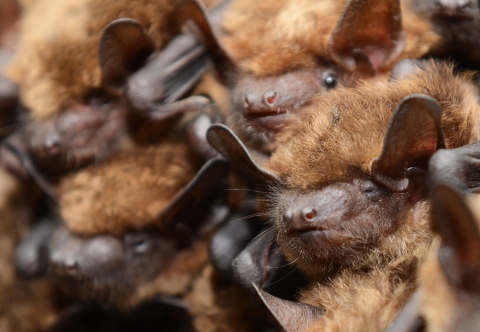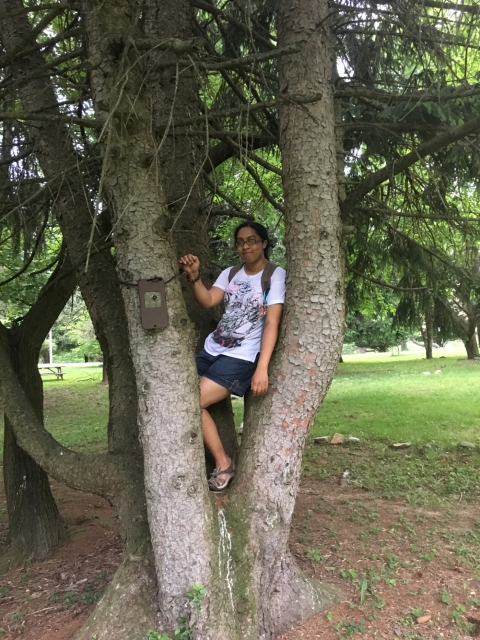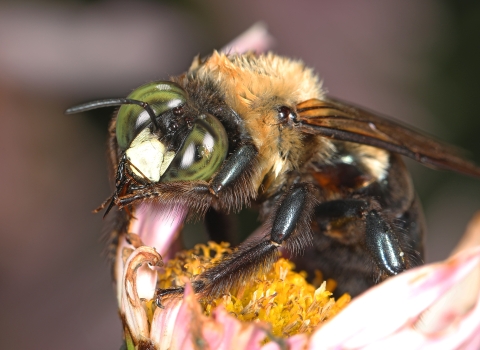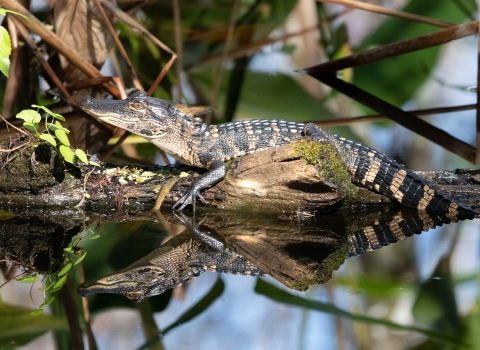Walking down the street in the city after dusk, you may notice it: A nimble, winged silhouette darting across the sky, illuminated by the streetlamps above. The figure is impressively acrobatic, quickly turning to and fro.
You might think, “That’s an odd flight pattern for a bird.” And you might be right; it could be a bat.
A lifetime’s worth of pop culture, television, and scary movies has taught us to presume bats live only in deep, dark caves, hanging from the ceiling among a crowd of jagged stalactites. While caves are indeed important to them, bats live in all kinds of habitats — deserts, forests, grasslands, suburbs, and perhaps surprisingly, cities.
With the ongoing development of urban spaces across the world, bat populations in cities are becoming increasingly common — they’re found roosting under bridges, in vacant buildings, and in the trees of parks. Austin, Texas’ Congress Avenue Bridge famously hosts the largest urban bat colony in the world, with roughly 1.5 million Mexican free-tailed bats residing beneath it every summer.
Our bat friends are a big part of our everyday lives as city dwellers — whether we see them or not.
A Love for the uncharismatic
When Dr. Ela-Sita Carpenter set out to become an urban wildlife biologist, she wasn’t exactly wild about bats; her introduction to them was more or less out of necessity. While pursuing her master’s degree in environmental science at Christopher Newport University, the only faculty member specializing in wildlife research focused on — you guessed it — bats.
“I had an initial reluctance about that, but the more I learned about bats, the more I ended up loving them,” says Carpenter, urban wildlife biologist in the Service’s Chesapeake Bay Field Office. “They’re such a unique mammal, and they get a bad rap, but they’re very important for the environment in so many different ways.”
She’s not kidding. Bats have been demonized in popular culture. They’re portrayed as carriers of deadly diseases that will suck your blood or swoop down and get tangled in your hair. Individual bats have sometimes paid the price for that misunderstanding.
The truth is we need them, and they need our help. Bats play essential roles in keeping pesky bug populations in check, pollinating our favorite plants, and dispersing fruit seeds to support tree growth across the world. Mangoes, bananas, avocadoes, chocolate, and coffee are just a few of the things we enjoy thanks to the help of bats. Their insect-eating prowess saves American farmers more than $3.7 billion in pest control each year, reducing pesticide use and protecting the health of our fields, gardens, and waters. Oh, and baby bats are called “pups.” What’s not to love?
Yet widespread habitat loss, climate change climate change
Climate change includes both global warming driven by human-induced emissions of greenhouse gases and the resulting large-scale shifts in weather patterns. Though there have been previous periods of climatic change, since the mid-20th century humans have had an unprecedented impact on Earth's climate system and caused change on a global scale.
Learn more about climate change , invasive species invasive species
An invasive species is any plant or animal that has spread or been introduced into a new area where they are, or could, cause harm to the environment, economy, or human, animal, or plant health. Their unwelcome presence can destroy ecosystems and cost millions of dollars.
Learn more about invasive species , and the fungal disease white-nose syndrome are driving bat populations into rapid decline. As many species face extinction, scientists are looking to urban bats to determine how they use these new habitats and what can be done to protect them.
Bats in Baltimore
Dr. Carpenter is one of those scientists. Her desire to raise awareness about bats — and help resolve the misconceptions people have — led her to a PhD in urban bat ecology. Her dissertation research focused on bat activity in her native city of Baltimore — specifically, what kinds of bats use vacant lots across the city to roost and forage, and what factors affect the level of activity across different species.
Considerably less-studied than that of birds, plants, and other pollinators, urban bat ecology is ripe for discovery. Cities provide unique bat roosts through buildings and bridges, water sources, and streetlamps, which attract insects (I.e., bat food!).
Dr. Carpenter was eager to explore these dynamics in the context of Baltimore, a city in which little to no prior bat research had been conducted.
Listening in on bats
Dr. Carpenter used a technique known as passive acoustic monitoring to find and identify bats. She deployed bat detector devices across 32 vacant lots to continuously record bats’ echolocation calls over three summer nights. Using special software, she analyzed the data to determine bat species based on the audio frequencies of their calls.
Spoiler alert: there were a lot of calls. More than 33,000 of them, all manually identified by Dr. Carpenter. Six bat species appeared in the data, with big brown bats making up 80–90% of the recordings and red bats following.
Dr. Carpenter’s research explored not just how environmental variables influence bat activity, but also how socioeconomics come into play. Neighborhood income, proportion of vacant housing, and race were common predictors of bat activity, as well as access to trees and nearby water sources.
Thriving or surviving?
So, how are bats adjusting to the hustle and bustle of city life? Are cities good for bats?
According to Dr. Carpenter, it depends — a response she can’t help but return to in discussing her research findings.
“I’m not trying to be evasive,” she says, laughing. “It really does depend on the species and location.”
Big brown bats, for example, are incredibly common across the country and appear to adapt just fine to city life. Other species, like the tricolored bat, currently under consideration for listing under the Endangered Species Act, showed only up once or twice in the data.
In terms of location, a city like Baltimore — with its vegetation, large number of parks, and three watersheds — will differ in bat presence from cities in other regions.
Getting a definitive answer to how bats are faring in cities will require more research. Dr. Carpenter’s work was dedicated to capturing bat activity; the next step would be analyzing bat health to determine if urban habitats are well-suited for them. Her data is expected to be incorporated into a global meta-analysis of bats across many cities to determine what physical traits are associated with living in cities.
While Dr. Carpenter’s research on bats has subsided, her passion for urban wildlife remains the same. In her work for the Service, she continues surveying wildlife and using outreach strategies to engage the Baltimore community with the nature in their backyard. Finding those connections to wildlife and inspiring residents in underserved communities to become stewards of their local environments remains central to Dr. Carpenter’s work.
How we can help
Our cities aren’t going anywhere, but that doesn’t mean we can’t make them better homes for bats; there are plenty of ways to welcome them to our neighborhoods.
Some cities are incorporating bat-friendly bridges as they replace aging infrastructure. Community parks and homeowners can install bat houses to offset a shortage of tree roosts and give some bats an alternative to roosting in attics.
Along with encouraging bat presence, it’s important to be conscious of the actions that are inadvertently harming bat populations. The home use of pesticides and bug zappers, which contain harmful chemicals and kill the insects that bats depend on, is detrimental. Excessive fertilizer use can harm water quality, impacting the insects bats eat and the water they drink. Urban gardeners can opt to use organic growing practices and limit the use of pesticides and fertilizers in gardening and lawn maintenance.
Finally, if you encounter a bat, refrain from handling it yourself; call your local animal control or public health agency for assistance in safely removing it.
The next time you’re out at dusk, keep an eye to the sky for the aerial acrobatics of a city bat and perhaps take a moment to ponder their evening adventures. Rural or urban, bats are everywhere — and we’re better off with them.






